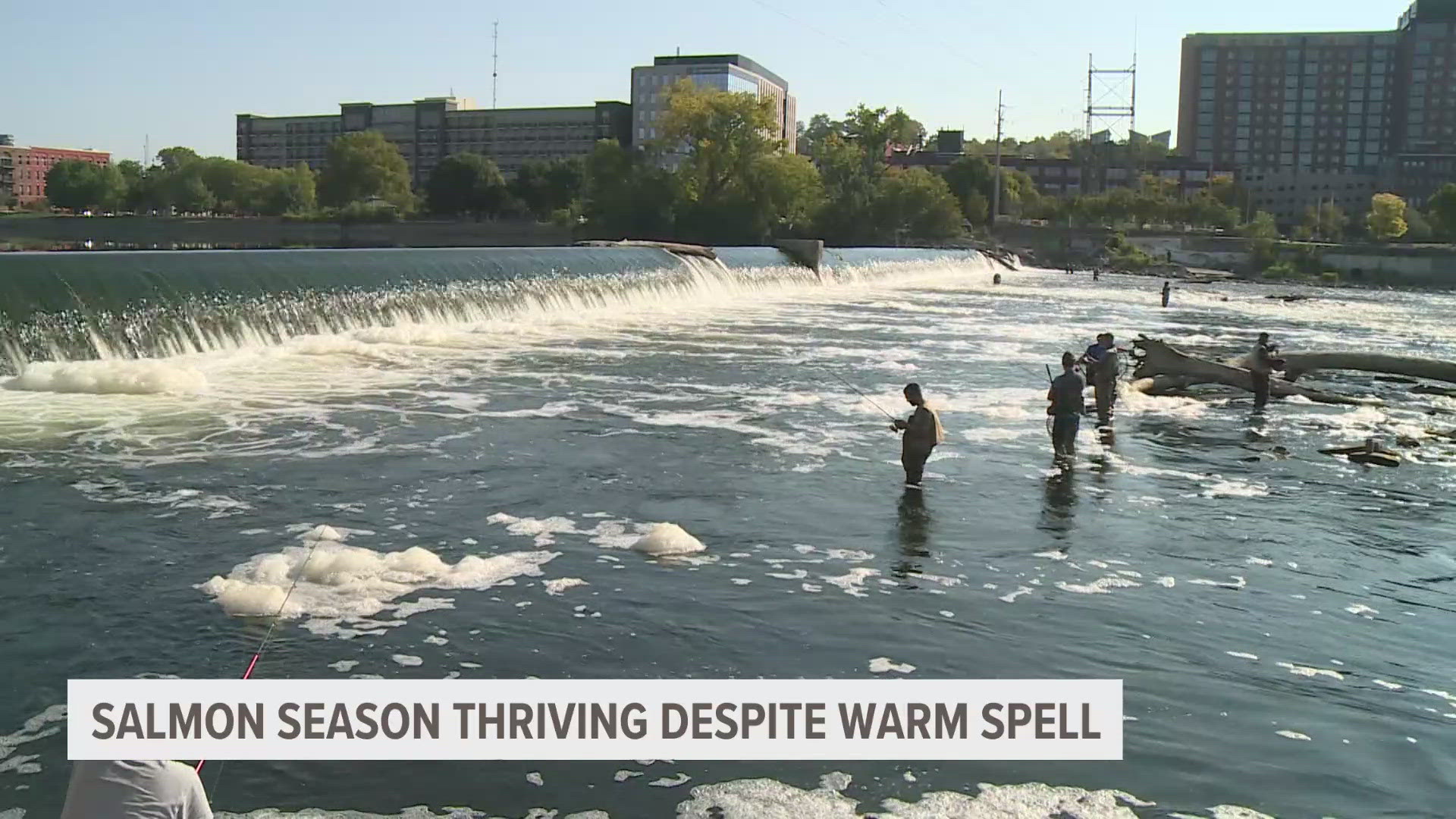GRAND RAPIDS, Mich. — September signals salmon fishing season in Michigan as summer transitions to fall when Chinook and Coho salmon migrate into river systems to spawn.
Tuesday marked eight consecutive days in the 80s in Grand Rapids, and if the streak holds, we could break the 11-day streak set in 1961.
Warmer temperatures don't always bode well for fishermen looking to land salmon as they make their fall run, and many note the bite has been slow.
We asked Assistant Chief of Fisheries Division Ed Eisch with the Michigan Department of Natural Resources how this fall salmon run is going and how weather can impact these fish.
Impacts hot weather has on salmon
Around Labor Day, salmon started their move from Lake Michigan into various river systems, like the Manistee, Pere Marquette, Au Sable, Platte River and Grand River.
"Salmon season is going full bore right now. There's still a lot of fish out in the lake, and there's fish in the rivers along Lake Michigan as well. It's been just a banner season...late summer season for Chinook and Coho. Fishing has been really strong as well," Assistant Chief of Fisheries Division Eisch said.
What typically signals fish it's time to migrate back to rivers to spawn is cooler temperatures.
Eisch said alongside cooler weather, the fish pick up on decreasing day length, too.
"Those low-pressure fronts where you get a lot of rain, increased flow, and that sort of thing in the rivers, that really signals them to come in," Eisch said. "So if we do start seeing a return to more normal fall weather, they're going to pour into the rivers, and that will probably be towards the end of the run. If it stays fair like it's predicted to, you can probably expect decent runs for another couple of weeks."
Whether the salmon are piled up in river mouths out in Lake Michigan or in river systems themselves, Eisch said decreasing daylight will allow water temperatures to drop.
Eisch doesn't have exact numbers for the Grand or the Pere Marquette rivers, but he said there are significant schools.
The DNR expert explains one key element to getting a big push upstream.
Rain's role in the salmon run
A combination of rain systems that increase the flow in rivers alongside lower barometric pressure gets salmon fired up.
"The fish can sense the pressure changes, the barometric pressure changes that go with fall storms," Eisch said. "That just seems to bring the fish in. They run more actively when that happens."
Pacific salmon, like Michigan's Chinook and Coho salmon, are a species that spawn once, and then die.
"This is their whole reason for being, is to try and pass on their genetic material to the next generation. So that urge to return to their natal streams or the streams where they're either hatched or stocked, if they're if they were stocked," Eisch said. "They will do everything they can to get there and literally spend the absolute last of their living energy to try and get the job done."
"But to get the really big pushes, to really get them absolutely storming in the rivers, you usually have those low-pressure fronts that come through rain systems," he said.
Should you change up your presentation?
Most seasoned fishermen will suggest salmon eggs as the first-line bait when targeting salmon making their run upstream, especially skein, to float into deep holes and seams.
Hard baits, like the ThunderStick, are another good option, while some anglers prefer spoons or jigs.
Despite these warmer temperatures, the DNR said the tried and true methods can still work to hook a river monster.
"The same program that works any fall is what they're going to want to use," Eisch said. "Now I wouldn't be changing up my program just because the temperatures are unseasonably warm. And I will add this: the fish that are still out in the lake [Michigan]. There are still a lot of immature fish that aren't going to run the rivers. And those fish that are near shore and are out in the lake right now, they're going to continue to feed throughout the fall, so lots of opportunities to be had out there."
As salmon get closer to spawning, their feeding behaviors do change, Eisch said. As the run gets closer to wrapping up, those fish will strike more out of aggression than in an effort to get a meal.
This unseasonable warmer weather can also be a good opportunity for those to be more comfortable casting their lines.
When we start getting into October, those salmon pushes will slow down, Eisch said.
"The numbers of fish are what they are, regardless of the weather. So those that are sexually mature and are going to run and try and spawn this year, they're gonna do so regardless of the what the weather throws," he said.
You can find the latest fishing regulations here.

